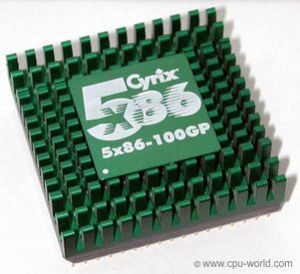Watch the Video
My (possibly) odd memories of the amazeballs Cyrix 5×86 and Cyrix 6×86 Processors. The best god damn processors you could buy (if you were on a budget as a teenage paper boy).
Let me tell you about what I’ve been pondering lately. You might have guessed already from the title of this article, either that or you’ve been grossly mislead. That’s right, I’m talking about Donkey’s that have been convicted of serious crimes…
Wait, no. I’ve not been pondering that at all. Sorry about that. What I have in actual fact been pondering, are the Cyrix range of chips. Which, depending on your angle, could be considered slightly less interesting. But, in fact, I am here to tell you otherwise (to me at least!) and explain exactly why I’ve been thinking about this fascinating subject.
Roll Back to the ’90s!
You see, it goes back to the mid-late nineties. I had become a “PC” owner over Christmas 1995 (much to the misfortune of my parent’s finances). My Atari ST and Amiga were slung aside, in favour of an Advent 4250 Personal Computer, fresh from PC World. At the time it boasted an AMD486DX/2 Micro processor, running at a mind blowing 50MHz and I’m not being at all sarcastic when I say that; 50MHz was pretty snappy back in ’95. The machine sported Windows 3.11 for workgroups, a 3.5″ floppy drive and a rather splendid, although headache inducing Energy Star compliant 14″ CRT screen (the 60Hz refresh rate was the headache inducing part).
So, this was all fine and dandy…. for a while… but no sooner had a few months passed, and it was my birthday. I wanted MORE. MORE POWER. MORE CAPABILITIES. MORE THINGS! EVERYTHING. And, so it began, the never ending desire to upgrade my fine machine whenever I had a spare bit of cash or present related events loomed.
The problem with upgrades back then was, primarily the cost (if you put compatibility issues aside). Memory was expensive, CD-ROM drives were expensive, graphics cards were expensive. Everything was expensive… So when it came to upgrading the core processing unit of my machine at Christmas ’96… there were limitations as to what I could “ask Father Christmas for” (I knew he didn’t exist at this point, I was 13). I wanted more raw processing power, but Santa couldn’t afford to get me one of those new fangled Pentium things. So, research was done, by me, thoroughly. PC magazine after PC magazine were read carefully. Processor benchmark tests were inspected diligently and the solution was exposed…..
A Cyrix 5×86 Microprocessor!
What a processor! It could be installed in my current motherboard. It was as fast as a Pentium (cue Intel musical loop), and it was cheap. Darn Cheap…. Plus it was gold… Take a look at this thing of beauty;
So there it was, it was installed, and all was good…. well… almost.
The Cyrix processors relied on a P/PR system for gauging their speed (although the term PR wasn’t established until the 6×86 chips released some 5 months later). The model I had was clocked as a P100. This meant that Cyrix considered it to be equivalent to a Pentium 100MHz processor. The thing is, these processors didn’t actually run at 100MHz like a true pentium. Instead, their architecture was “improved” over that of a Pentium (Cue Intel music again), and so a lower rated Cyrix chip, could perform at the same level as a much faster Intel chip.
What’s more the Cyrix processor lacked many of the instruction sets found within the Pentium architecture. It wasn’t a 486, for sure. It had many Pentium design elements. However, the fact it was missing some, meant that it wasn’t a Pentium either, and so didn’t work as well with a lot of software and games. In fact, games designed specifically for the Pentium architecture, wouldn’t run on a Cyrix.
So, the processor wasn’t as fast as I’d hoped it would be. Sure it was faster, it was definitely a huge improvement on my 486, but it wasn’t as I expected and so I was a little disappointed. But like a man with a lower specification car than his friends, I rooted for that chip like it was my own god damn child, and indeed, I still do.
I took massive pleasure out of pushing every inch of power out of that machine as possible. Of course a faster processor, was useless with my Trident “piece of scrap” video card, and so that was also swapped out for a Diamond Edge 3D. Such was my desire to upgrade my machine back in the 90s that, as you may be able to tell, I still find researching these things, reading benchmarks on massively outdated hardware and playing around with this stuff exciting. It’s like a strange childhood competitiveness is stirred, and I still get the urge to upgrade a 90s machine to it’s peak specification (circa 1996), regardless of the fact that I’m typing this article on a laptop that is 100x or so more powerful! It’s just not the same.
After the 5×86, I stayed loyal to the brand and went down the route of the 6×86 and MMX processors (Although I think I ultimately, ended up with an AMD K6 – My Advent 4250 was thrown away, much to my shock, so the proof is gone). Both having their distinct advantages and disadvantages over Intel hardware (Quake on a 6×86 anyone….? errr, no). But that’s a story for another day.
So, here we are. This is why I have been pondering the Cyrix chip recently. It’s why I am looking at buying one on eBay for the reasonable sum of £30 (I imagine it’s probably worth it for the gold value alone) and it’s also why you are reading this right now.
Do you feel the same? I doubt it. Although the fact you’ve read up to here, may mean that you do…? Either that or you’re doing some obscure research project and finding this utterly mind crippling to read. Hmmmm, either way, let me know in the comments!

Nostalgia Nerd is also known by the name Peter Leigh. They routinely make YouTube videos and then publish the scripts to those videos here. You can follow Nostalgia Nerd using the social links below.






1 Comment
Add Yours →I recently acquired an IBM 365ED laptop, which happens to feature this proccessor. In windows 95 its shown as a “CyrixInstead” cpu, so ive figured that out with a bit of research. I cannot find any info about this chip being BGA, nor about a bga type socket 3, and mine is soldered to the mobo. Maybe it was unique to the Thinkpad line? I dont know.. thats why im still doing the research 😀